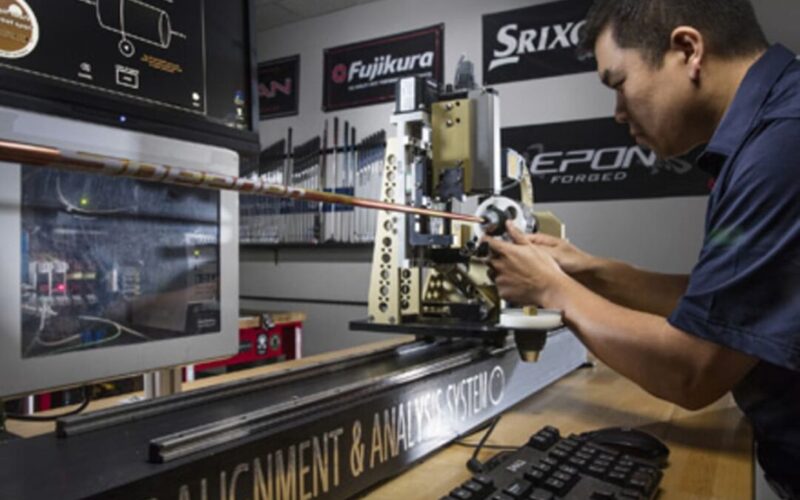Rory McIlroy and Shane Lowry shot an 11-under 61 in four-ball play Thursday for a share of the first-round lead at TPC of Louisiana.
To Pure or Not to Pure

We all know the days of walking into a shop and buying a club or clubs off the rack are long gone. Getting fitted is engrained in the brain and rightfully so. It absolutely 100% makes a difference, no matter the handicap or ability of the player. But to what extent does an aspect of fitting become irrelevant or “smoke and mirrors” if you will. An old adage used to be if you play larger grips it will slow your hands down and you’ll hit more of a fade and less of hook, and vice versa. There’s never been any testing to prove that theory, so to that I say…hogwash. It’s more of a personal preference and relative to hand-size than ball flight properties. But in my opinion the biggest piece of hot garbage within the club fitting realm is pureing or getting your shafts spined.
I’d put good money on most people never hearing about this process, and of those that have, more than half of them not knowing what to spine or pure a shaft even means. Yet there are a couple respected “boutique” fitting/retail locations that not even stand by this method, but push it onto their consumers…and at a price. They charge upwards of $30 per club to have it done.
Ok Seth, so what does it mean to spine or pure a shaft? The textbook answer is a specialized machine locates the optimal orientation of the shaft that will lead to the most stability. In simple terms, you are trying to figure out which way the shaft should go into the head for optimum performance. It could be graphics up, it could be graphics down. It could even be graphics to the side. The thought is that not every shaft is perfectly round or perfectly straight, so you are looking for its neutral axis or most stable plane. From there, getting that shaft installed in the perfect position will lead to a more consistent combo of distance and accuracy.

To spine a shaft is similar to puring a shaft but is a bit different. To spine a shaft means to install if with most consistent bending position pointing directly toward or away from the target line. To check this, the fitter or clubmaker will use a vice and maybe even a laser for accuracy. The club is secured into place and the butt end is pulled on horizontally, or side-to-side. When let go the shaft oscillates back and forth. If the back and forth movement creates an oval pattern or a figure 8, the shaft position isn’t ideal. Once it goes back and forth on a single plane, or flat line, the shaft is ready for final installation into the head.
Many players swear by the method, and I will admit the concept sounds believable. But I need hard data or concrete statistics to believe it makes a substantial difference. Proponents of the process have been quoted in saying almost $2 billion have been earned by PGA Tour players who have had their shafts pured. With that said, how much money has been won by those who haven’t? And let’s be honest, if you tell a tour player that if they eat spam on Thursdays and put a dead squirrel in their bag that they’ll win…they’re probably gonna do it.
The grey area here that clouds this entire theory is what the shaft manufactures have to say. It is highly unlikely that True Temper or Fujikura is going to come out and say “Hey, that $350 driver shaft you just bought isn’t perfect and you are going to have to pay someone more money to make it perform well.” Their stance is that they put out industry-leading technology and this process doesn’t significantly improve the performance of our products.
Another point to consider is the adjustable hosel that 90% of drivers on the market contain. When you bust out your wrench and tweak the club’s loft or lie, you are altering the shaft orientation.
So are you to tell me that if you spined or pured your shaft at the Standard setting, then 2 months later adjusted your setting to +1° of loft your shaft is no longer in a position of optimal performance because it’s been rotated?
I have been aware of this procedure for over a decade and have seen it done in person. Yet I have asked many fitting reps from the major club manufacturers, and even the lead fitter at Callaway in Carlsbad HQ, their thoughts on pureing and if they think it makes a difference or is necessary. The response is an overwhelming, resounding NO. There is no data and no testing that shows this theory to be false. But there is not enough evidence to prove it to be necessary. Some purists (see what I did there) had some testing done by Golf Labs on a robot which made their claims hold some value. But robots are good for research and development to see how a club reacts under normal playing conditions. Robots don’t play golf, people do.
As a Top 100 fitter in the country, I can count on one hand how many players I’ve had inquire about this. And I don’t need any hands to count how many times I’ve recommended it be done.
Enjoy the game and each other,
Seth Zipay – Head Golf Professional
